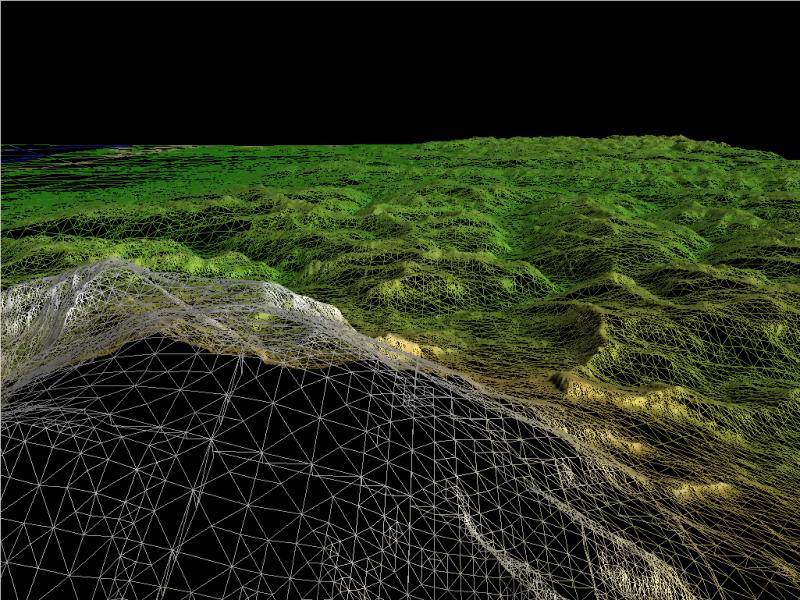|
geekstuff | gameswf | Textweb | Chunked LOD | dumbuild |
| Cheat sheets: CVS | cygwin | Debian | Emacs | MythTV |
Chunked LOD


Since summertime of 2001, I've been doing some personal research into hardware-friendly continuous LOD. I think I've got a method that's about as good as CLOD can be for T&L hardware. It renders CLOD, with geomorphs, using batched primitives. It's very friendly to texture LOD and paging data off disk. The downsides include a long preprocessing phase, and some size overhead for the disk file. Actually another thing that bugs me is that the data isn't in a convenient form for doing height/collision queries. But otherwise it really rocks.
News
28 Jan 2004 -- Somebody just clued me in: this work has been extended with some fancy features and integrated with OpenSceneGraph. See http://www.intrepid.com/~vladimir/osg/. Cool stuff includes hardware mip-map generation, vertex-morphing using a Cg vertex program, etc. Awesome.
6 Aug 2002 -- Released programs and data from SIGGRAPH presentation. See downloads.
25 July 2002 -- Back from SIGGRAPH. Presentation went pretty well, the demos worked well (on my laptop at least -- their preso machines showed a weird bug that I'm hoping to get some help with). At the last minute I discovered I could cut memory use by about 3x by using Doug Lea's malloc (http://gee.cs.oswego.edu/dl/html/malloc.html). (Upon further investigation, it turns out there was an old MSVCRT.DLL in my path [Tcl8.3's fault, doh]. The correct MSVCRT.DLL from Win2K performs much better; about the same as Doug Lea's malloc.)
See link to slides in the docs section.
I'll put up some demos w/ data soon.
23 June 2002 -- New screenshots above. Shows 32K x 32K quadtree-tiled texture on puget dataset. The texture was generated from the 16K x 16K source heightfield, using a simple altitude-to-color mapping, and lighting based on slope. The 32K x 32K texture takes about 61MB in jpeg format. For rendering, that texture gets chopped up into a 9-level quadtree where each node is an independent 128 x 128 jpeg-compressed image. The geometry here was processed w/ a 4 meter error tolerance, rendered here w/ around 2-pixel screen-space error tolerance, at a resolution of 1024x768 (the images above are scaled down to 800x600). The framerate here is ~30 fps on 1GHz P3 w/ GeForce2Go.
16 April 2002 -- I've checked in a draft of the SIGGRAPH course notes in pdf format. I'm going to retire the MSWord version soon, following my adventures w/ LaTeX. LaTeX is nightmarish, but the equations and pdf output are better, and I can edit in emacs.
31 March 2002 -- I'm flying around the 16K x 16K Puget Sound dataset (kindly made available by Peter Lindstrom, the University of Washington, and the USGS; have a look at it here: http://www.cc.gatech.edu/projects/large_models/ps.html and also the associated paper by Lindstrom and Pascucci, http://www.gvu.gatech.edu/people/peter.lindstrom/papers/visualization2001a/ ). Frame rate is good. The geometry actually isn't that challenging for the LOD algorithm -- real DEMs often aren't. The real world at a 10 or 30 meter sample frequency just isn't that bumpy. John Ratcliff's fake moon dataset (available from the .BT repository at http://vterrain.org/BT/index.html ) is tougher from a geometric LOD standpoint, because it's much rougher. However it's only 1K x 1K, so it's not difficult to deal with from a data-size point of view.
The Puget Sound data, on the other hand, is pretty big. At 16K x 16K x 16 bits, the raw heightmap data file is 512MB. The preprocessed chunk file is about 214MB if I decimate to within a 4-meter error tolerance (Hughes Hoppe's PM demo of the same dataset to a 4-meter tolerance takes 256MB when it's unzipped, see http://research.microsoft.com/~hoppe/sr_puget.asp for the cool demo.) If I decimate to a 1-meter max error tolerance (takes maybe half an hour ):, which is much more interesting, the data file is just over 1GB!
For comparison, Lindstrom & Pascucci describe a system that visualizes the same dataset at the full resolution (no predecimation), storing 20 bytes per vertex, which works out to 5+ GB, but they're also clear on the fact that they didn't try too hard to get the per-vertex data-size down. A data-optimal version of their approach would use 3 bytes per vertex, I think: 2 bytes for height, and 1 byte for error. That would work out to about 800MB.
Downloads
Code and binaries from the version shown at SIGGRAPH2002. Updated 2002-08-06. Contains source for Win32 & Linux, executables for Win32, and John Ratcliff's crater dataset.
Additional data files, hosted at SourceForge:
Riverblue, 99 MB Exported from MojoWorld (http://www.pandromeda.com)
If you can afford the download time & disk space, the Puget Sound dataset is the most impressive, technically, because it's so big. I find the data itself fascinating. Riverblue has the best texture.
SVN access to the latest source code to the viewer and preprocessing tools: http://sourceforge.net/svn/?group_id=31763 . You can build from scratch on Linux or Win32.
License
All the source code for this project has been placed in the public domain. Do whatever you want with it; no copyright, no restrictions whatsoever. The code comes with ABSOLUTELY NO WARRANTY.
Documentation
I presented this stuff at the "Super-size it! Scaling up to Massive Virtual Worlds" course at SIGGRAPH 02.
The draft of a paper explaining everything (Results section conspicuously absent -- I'm still working on some things) pdf format, latest from SVN | pdf format, local copy
Slides from the presentation.